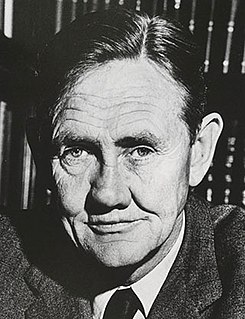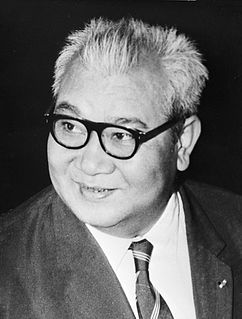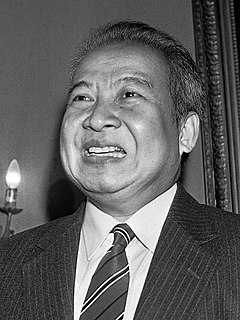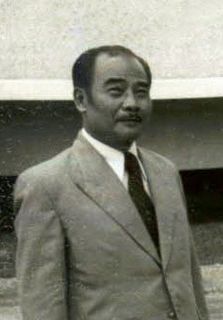 W
WLeonid Ilyich Brezhnev was a Soviet politician who led the Soviet Union as General Secretary of the governing Communist Party (1964–1982) and as Chairman of the Presidium of the Supreme Soviet (1977–1982). His 18-year term as general secretary was second only to Joseph Stalin's in duration. While Brezhnev's rule was characterized by political stability and notable foreign policy successes, it was also marked by corruption, inefficiency, economic stagnation, and rapidly growing technological gaps with the West.
 W
WBrigadier General Ralph T. "Tom" Browning, was a United States Air Force command pilot who was a prisoner of war (POW) during the Vietnam War, was the Commander of two Air Divisions, and Commander of the 58th Fighter Wing, Luke Air Force Base, Arizona. After retirement from the USAF, he became CEO of Greater Phoenix Leadership, Inc. in Phoenix, Arizona, a business organization supporting community improvement efforts in the areas of transportation, education and economic development.
 W
WPrince Norodom Chantaraingsey was a member of the Cambodian royal family and a Cambodian nationalist. Initially a leader of the guerrilla resistance against the colonial French, he went on to become a prominent general in the Khmer National Armed Forces (FANK) during the Cambodian Civil War, as well as a businessman and occasional writer.
 W
WHubert van Es was a Dutch photographer and photojournalist who took the well-known photo on 29 April 1975, which shows South Vietnamese civilians scrambling to board a CIA Air America helicopter during the U.S. evacuation of Saigon. The picture was taken a day before the Fall of Saigon.
 W
WBernard B. Fall was a prominent war correspondent, historian, political scientist, and expert on Indochina during the 1950s and 1960s. Born in Austria, he moved with his family to France as a child after Germany's annexation, where he started fighting for the French Resistance at the age of sixteen, and later the French Army during World War II.
 W
WHenderson Alexander Gall, is a Scottish journalist, author, and former ITN news presenter whose career as a journalist has spanned more than 50 years.
 W
WSir John Grey Gorton was the nineteenth Prime Minister of Australia, in office from 1968 to 1971. He led the Liberal Party during that time, having previously been a long-serving government minister.
 W
WLe Ly Hayslip is a Vietnamese-American writer, memoirist and humanitarian. Through her foundations, she has worked to rebuild cultural bridges between Vietnam and America following the Vietnam War.
 W
WHarold Edward Holt,, was an Australian politician who served as the 17th Prime Minister of Australia, in office from 1966 until his presumed drowning death in 1967. He was the leader of the Liberal Party during that time.
 W
WSir Keith Jacka Holyoake, was the 26th Prime Minister of New Zealand, serving for a brief period in 1957 and then from 1960 to 1972, and also the 13th Governor-General of New Zealand, serving from 1977 to 1980. He is the only New Zealand politician to date to have held both positions.
 W
WHun Sen is a Cambodian politician who has served as the Prime Minister of Cambodia since 1985, the longest-serving head of government of Cambodia, and one of the longest-serving leaders in the world. He is also the president of the Cambodian People's Party (CPP) and a member of the National Assembly for Kandal. His full honorary title is Samdech Akka Moha Sena Padei Techo Hun Sen. Born Hun Bunal, he changed his name to Hun Sen in 1972, two years after joining the Khmer Rouge. From 1979 to 1986 and again from 1987 to 1990, he served as Cambodia's foreign minister. At age 26, he was also the world's youngest foreign minister.
 W
WPhilip Jones Griffiths was a Welsh photojournalist known for his coverage of the Vietnam War.
 W
WField Marshal Thanom Kittikachorn was a Thai military dictator. A staunch anti-communist, Thanom oversaw a decade of military rule in Thailand from 1963 to 1973, during which he staged a self-coup, until public protests which exploded into violence forced him to step down. His return from exile in 1976 sparked protests which led to a massacre of demonstrators, followed by a military coup.
 W
WJanusz Lewandowski was a Polish diplomat, known for arranging the Operation Marigold, a failed secret attempt to reach a compromise solution to the Vietnam War.
 W
WMarshal Lon Nol was a Cambodian politician and general who served as Prime Minister of Cambodia twice, as well as serving repeatedly as defence minister and provincial governor. As a nationalist and conservative, he led the military coup of 1970 against Prince Norodom Sihanouk, abolished the monarchy, and established the short-lived Khmer Republic. Constitutionally a semi-presidential republic, Cambodia was de facto governed under a military dictatorship. He was the commander-in-chief of the Khmer National Armed Forces during the Cambodian Civil War. After the Khmer Rouge captured Phnom Penh, Lon Nol fled to the United States, first to Hawaii and Michigan then to California, where he remained until his death in 1985.
 W
WTrusten Allan McArtor was the Administrator of the U.S. Federal Aviation Administration from 1987 to 1989.
 W
WSir Robert Gordon Menzies,, was an Australian politician who twice served as Prime Minister of Australia, in office from 1939 to 1941 and again from 1949 to 1966. He played a central role in the creation of the Liberal Party of Australia, defining its policies and its broad outreach. He is Australia's longest-serving prime minister, serving over 18 years in total.
 W
WMichael Nicholson OBE was an English journalist, specializing in war reporting, and a newscaster. He was ITN's Senior Foreign Correspondent.
 W
WPrince Boun Oum was the son of King Ratsadanay, and was the hereditary prince of Champassak and also Prime Minister of the Kingdom of Laos from 1948–1950 and again in 1960–1962.
 W
WKaysone Phomvihane was the first leader of the Communist Lao People's Revolutionary Party from 1955 until his death in 1992. After the Communists seized power in the wake of the Laotian Civil War, he was the de facto leader of Laos from 1975 until his death. He served as the first Prime Minister of the Lao People's Democratic Republic from 1975 to 1991 and then as the second President from 1991 to 1992.
 W
WPol Pot was a Cambodian revolutionary and politician who governed Cambodia as the Prime Minister of Democratic Kampuchea between 1975 and 1979. Ideologically a Marxist–Leninist and a Khmer nationalist, he was a leading member of Cambodia's communist movement, the Khmer Rouge, from 1963 until 1997 and served as the General Secretary of the Communist Party of Kampuchea from 1963 to 1981. Under his administration, Cambodia was converted into a one-party communist state governed according to Pol Pot's interpretation of Marxism–Leninism.
 W
WNorodom Sihanouk was a Cambodian politician who led Cambodia in various capacities throughout his political career, but most often as the King of Cambodia. In Cambodia, he is known as Samdech Euv. During his lifetime, Cambodia was variously called the French Protectorate of Cambodia, the Kingdom of Cambodia (1953–70), the Khmer Republic (1970–75), Democratic Kampuchea (1975–79), the People's Republic of Kampuchea (1979–93), and again the Kingdom of Cambodia.
 W
WSisowath Sirik Matak was a member of the Cambodian royal family, under the House of Sisowath.
 W
WPrince Souphanouvong was, along with his half-brother Prince Souvanna Phouma and Prince Boun Oum of Champasak, one of the "Three Princes" who represented respectively the communist (pro-Vietnam), neutralist and royalist political factions in Laos. He was the figurehead President of Laos from December 1975 to August 1991.
 W
WF. Romuald Spasowski, once an ardent Communist and Poland's ambassador to the United States, is best known for having defected at the height of the Solidarity crisis in 1981.
 W
WWangyee Vang is a Hmong-American community leader, educator and elder from Fresno, and the Central Valley, of California.
 W
WEstimates of casualties of the Vietnam War vary widely. Estimates include both civilian and military deaths in North and South Vietnam, Laos, and Cambodia.
 W
WEdward Gough Whitlam was the 21st Prime Minister of Australia, serving from 1972 to 1975. He led the Australian Labor Party (ALP) to power for the first time in 23 years at the 1972 election. He won the 1974 election before being controversially dismissed by the Governor-General of Australia, Sir John Kerr, at the climax of the 1975 Australian constitutional crisis. Whitlam remains the only Australian prime minister to have been removed from office in this manner.